Men's tunic from Birka
There are tunics and there are tunics. Some tunic remains from the Swedish trading metropolis of Birka show a certain, characteristic kind of decoration which might reflect its influences from foreign countries. In this article, some archaeological evidence from the "Birka tunics" has been collected. The content has been structured according to the questions: What kind of fabrics do we have? What kind of decoration has been used on the tunics? Where on the body where the decorations located?
What kind of fabrics do we have?
From the 14 graves with evidence of a tunic (according Birka II-21 ), Inga Hägg mentions remaining fabrics for only eight. One of those has been described as "W 2" - a woolen four with 5 threads per cm in warp and 4-5 threads per cm in weft2 . In five other graves, fabrics have been described as "wool" but there is no information on type of weave or density of threads. In two other graves, the main fabric had been linen or hemp and for one grave it only says "tabby weave" without any further information.
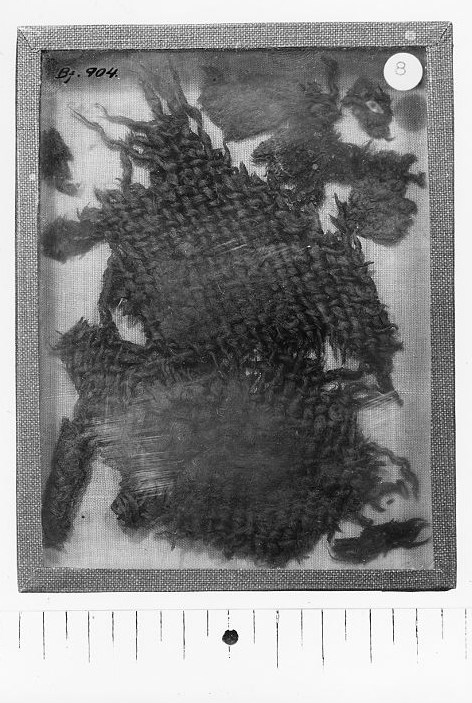
What kind of decoration has been used on the tunics?
Decorative elements in the tunics from Birka include silks, embroidery in silk and silver thread, and tablet woven bands with silver.
Two different types of silks have been described: S 1, a kind of taffeta silk, tabby weave with around 28 threads per cm in warp and weft, of very high quality, and S 4, a silken twill with a woven-in pattern of different colours. The thread count varies from piece to piece, but the weft generally seems to be denser than the warp2 . Silken fabrics appear in eight of the 14 graves.
Embroidery appears in only one of the graves: Bj 735 A. The double grave Bj 735, containing a man and a woman, is famous for its large textile remains of silk and tablet woven bands. Formerly the textile fragments have been attributed to the man only2 . However, a later re-analysis has shown that only some of those fragments belonged to the man and the rest to the woman4 . Most of the textiles attributed to the man have been interpreted as being the remains of a tunic1 , with two types of embroidery: St 3, which is made with silken thread on a silk fabric o type S 4 and describes a stepped line. The other one, St 8, was made in ösenstich with a fine silver thread, again on S 4 silk. The embroidery describes a stepped line of more complex character than St 3. The embroidered silken fragment is around 15cm long and 1.5cm wide, another two fragments would be just as long when put together.
Tablet woven bands with silver thread appear in all graves with decorated tunics. In some cases they are the only evidence of this garment, together with the silk they were sewn onto. The band fragments are of different lengths and show a variety of patterns. What they have in common is the material: silk and, to some degree, linen thread with a weft of silver thread creating the pattern. The silver thread was always drawn and round in cross section, never flat. The width of the tablet woven bands varies between 8 and 17mm.
Where on the body were the decorations located?
This is generally difficult to determine, since, as Inga Hägg wrote: "These identifications are being hindered by the fact that we do not know the exact locations in the graves. Often it is difficult, if not impossible to decide where exactly in the grave the preserved bands and ornaments were located, which tablet woven band corresponds to a marking on the plan etc., especially since it is almost never the case that all decorations are marked on the plan. Furthermore, the skeletons were, as was mentioned, already completely gone when the excavation took place and could thereby not be marked on the plans" (Birka II-2, "Die Tracht"1 S. 69f.; my own free translation).
This being said, where it was possible there have of course been some attempts to reconstruct the position on the body. The following paragraphs will focus on each Birka grave with tunic remains in turn before coming to a conclusion. The extend to which the decorations seem to have been used will also be discussed here.
Bj 703 A. The grave has been interpreted as a double grave of a man and a woman and the silver bands that have been found were attributed to the man's body. Two silver bands of different types were found: a 20cm long band of the type B 4 which has been sewn onto a piece of S 4 silk and another, shorter but also wider band of the type B 3. The man's bones, probably together with the silver bands, have been moved in antiquity to make room for another grave3 , so that it does not lie in its original position any longer.
Bj 716. Only traces of the skeleton are preserved in this grave3 . Another garment that had been buried with the deceased is a caftan with a row of buttons which was worn together with a richly decorated belt1 . While the belt fittings seems to lie more or less in their original position on the grave plan, the caftan buttons seem to be scattered to some degree. Did the buttons roll to the sides when the lying body sank together during decay or is this an indication that the upper part of the body sat upright, perhaps leaning to something which has since rotted away? If the latter was the case, any dress detail positions from the upper body would be comparatively uncertain since they would have moved much more during decay. On the grave plan there is an appr. 26cm long silver band of the type B2 lying diagonally west of the belt and buttons (where the upper body might have been). In my opinion, it cannot be said with certainty whether it would have been sewn onto the tunic in the same position or not.
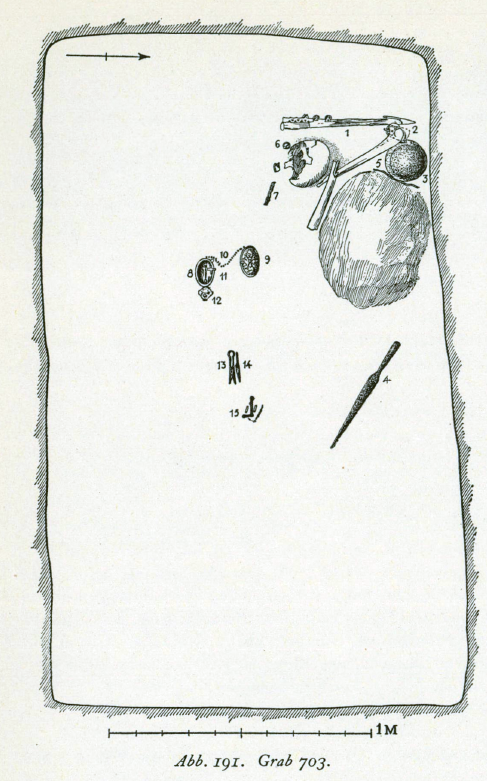
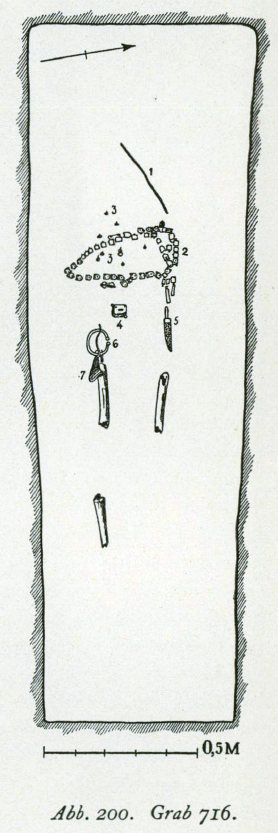
Bj 735. When Inga Hägg re-analysed the textiles from this grave, she also commented on their original position on the body. The following pieces were attributed to the man's garments 2 4 1 : The silken strips of cloth (S 4) with embroidery of type St 8 in silver thread, possibly positioned at the waist. The silk fabric has been folded over on one side, the other has been decorated with a braid of "Spiralsilber". As mentioned above, the fragments are only some 30cm long if all put together, so it is uncertain whether the band would originally have reached all around the garment or would only have marked one particular spot. The other embroidery, St 3, comes from the same garment, but the position is unclear. The fine silken fabric it had been sewn onto would have been covering the main fabric of grey-blue wool. Above the embroidery St 8, oriented the same way, lay six tablet-woven bands; close to the sword (which lay just next to the body) were another two. They were sewn to silk fabric of varying quality. The preserved silver band fragments vary in length between 16cm (B 17), 13cm and 7cm (B 18) and 5cm, 11cm, 12cm, 15cm and 17cm (B 20). Inga Hägg locates them in the chest area.
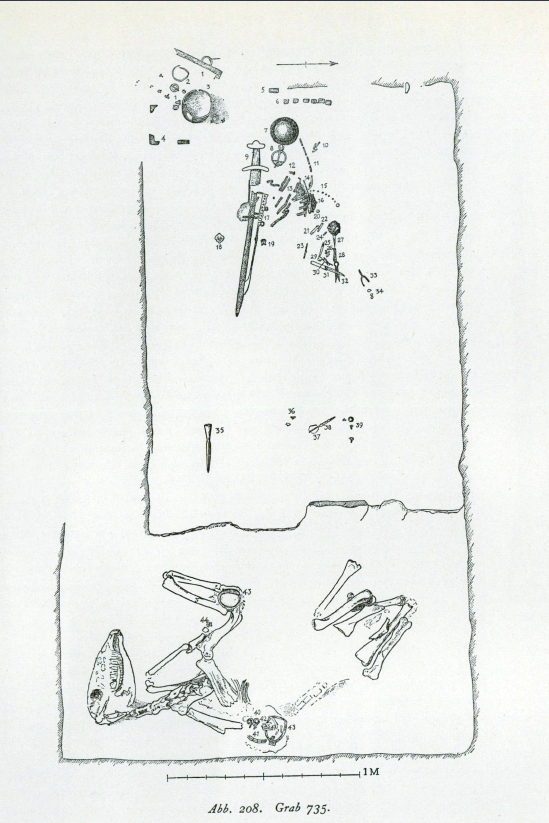

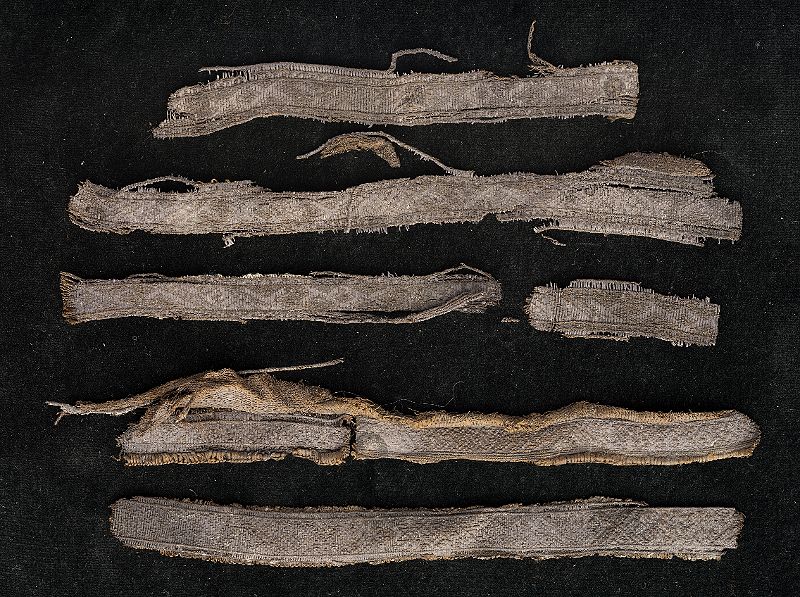
Bj 842. According to the grave plan3 , nothing of the skeleton remains. Some woolen fabric, silk of the type S 4 and a tablet woven band are what remains of the tunic1 . The silver band lay parallel to the sword handle, but somewhat closer to the head2 . Without any bones or other finds giving some orientation, it is impossible to determine which exact part of the upper body (an area around the throat? Part of the chest? Part of an arm?) it would have decorated. The band would have been a little longer than 20cm.
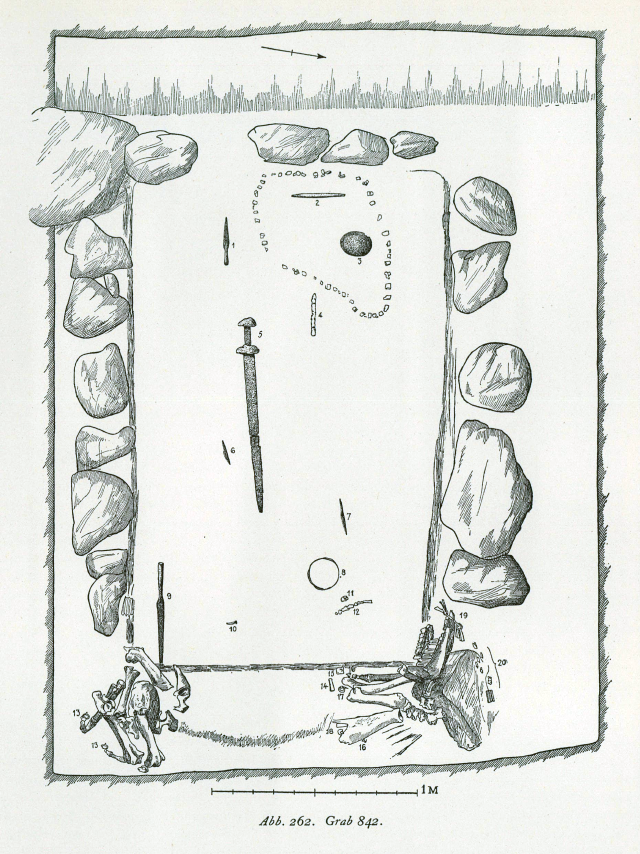
Bj 855. The tablet woven bands of 7 and 8cm (as well as some fragments) were positioned between the shoulder and the elbow 2 . Some silken fabric has been found, too (S 4), as well as some very dense woolen twill (perhaps diamond twill) with 40 threads per cm in one direction1 . It is unclear, but likely, that the tablet woven band was sewn onto the silk fabric, considering that this also seems to be the case in other graves.
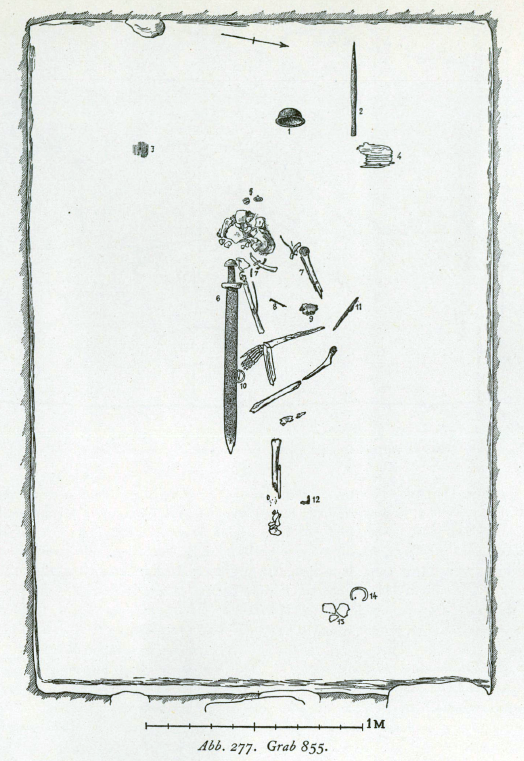

Bj 903. The tunic from this grave was made of linen or hemp. Several fragments of tablet woven bands (B 3) were preserved , too, of which one lay on the chin, two parallel pieces on the right shoulder, one on the left shoulder and one piece each at the lower arms. The longest fragments are 14cm, 9cm, 8cm and 7cm long 2 . The grave plan shows the jaw bone at the left shoulder, which means that there were two woven bands on the left shoulder as well as on the right. All the fragments are drawn in a right angle to the arms.
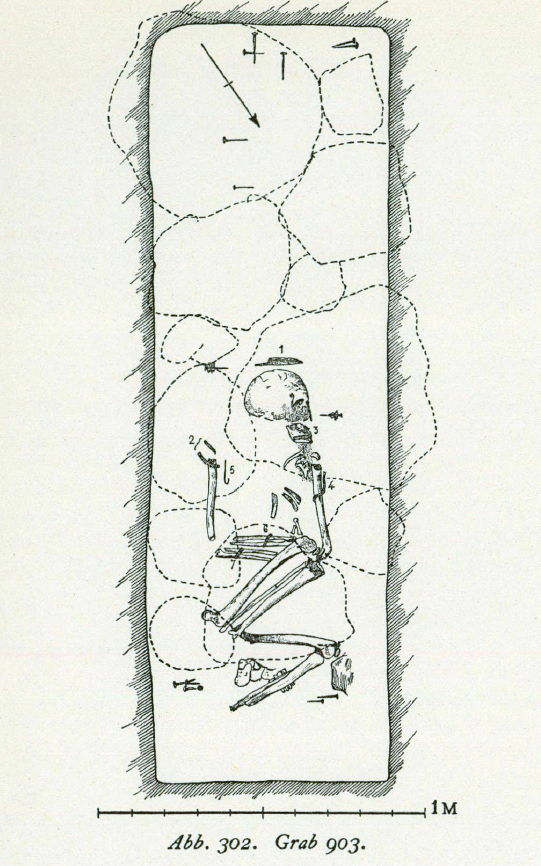
Bj 904. No decorative tunic elements remain from this grave. A comparatively roughly woven piece of woolen fabric, W 2, however, has been attributed to the tunic.
Bj 944. Quite a lot of textile remains (including decorative work in silver wire) come from this rich grave. Of the tunic, the following elements are preserved: Fabric of linen, silk (S 4), possibly with a woven-in pattern and tablet woven bands (types B 6 and B 7), which reached from the shoulder to the calfs. The arm pieces were lengthwise decorated with silver bands as well and ended with another band around the arm seam1 .
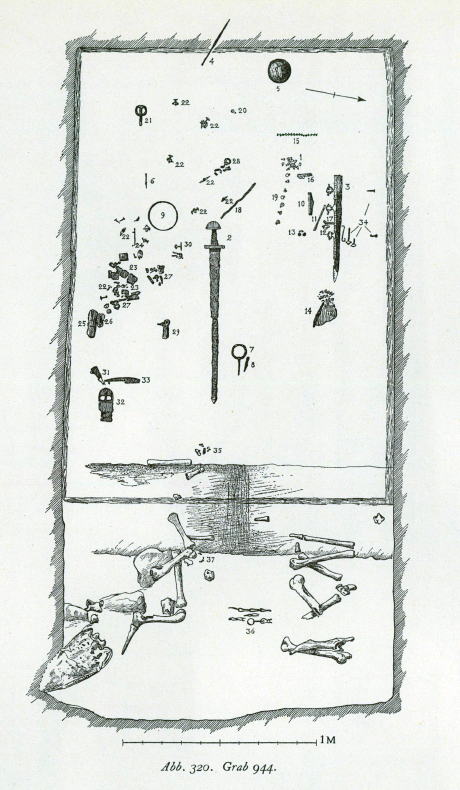
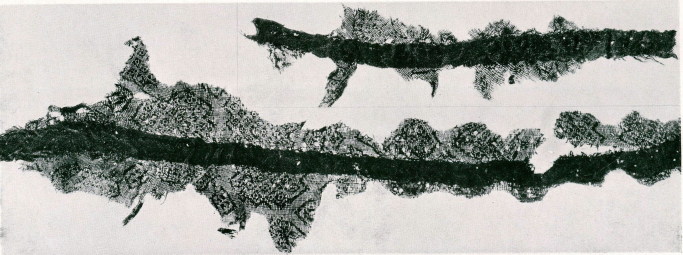
Bj 957. A woolen tunic1 , decorated with several tablet woven silver bands (tapes B 6 and B 7) which were sewn onto silken fabric of the type S 4. On the grave plan, 4-5 bands lie close together in the area where the chest of the deceased would have been3 .
Bj 958. The grave plan shows a silver band reaching from one shoulder to the other, covering the front of the chest 3 . Evidence of silken fabric (S 4) could be found as well1 . Perhaps the silver band was sewn to the silk, as in some of the other graves?
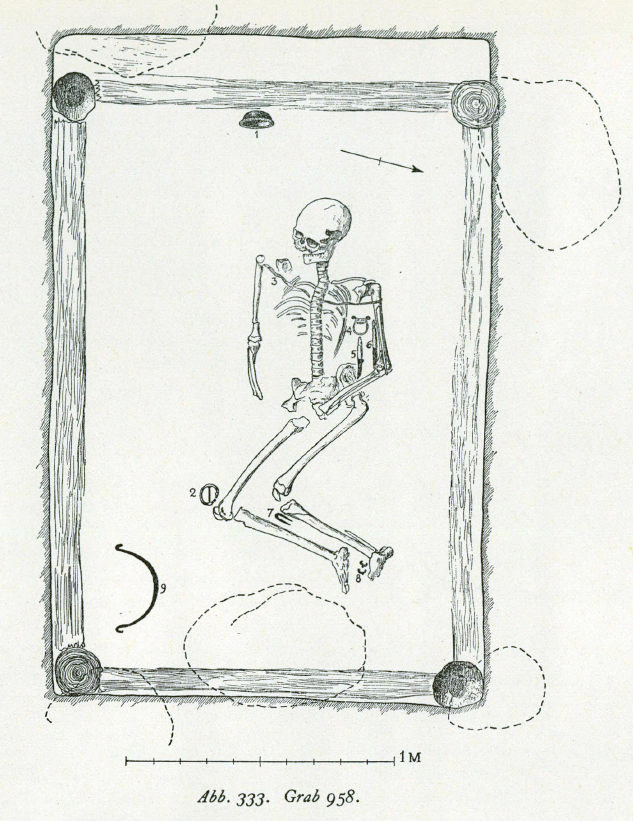
Bj 977. To the tunic belonged tablet woven silver bands of the types B 5 and B 8 2 1 . On the grave plan one band lies approximately where the neck would have been3 . Geijer argues that it might have slid down from the head2 but since most of the skeleton is gone, it can't be said for sure. If it came from a tunic, it might have decorated the neck area.
Bj 1074. The only information on textile remains from the tunic in this grave is the mention of "Tuchgewebe" ("tabby weave") by Inga Hägg1 without further explanation on the material (wool, linen/hemp, silk) or location.
Bj 1076. The tunic in this grave was decorated with a silver band (B 10) which formed a rectangle on the chest measuring around 10 x 35cm, with one corner at the chin and the other at the waist.
Bj 1125 B. There is almost no information on the tunic in this grave. It was decorated with a silver band of the same type as the one from Bj 1076, but it is not marked on the grave plan. I was not able to find out anything on the size of the band or the position it might have had relative to the body.
Conclusion: As far as the evidence goes, embroidery was only sparely used. The silken embroidery from Bj 735, however, indicates that embroidery with non-metal thread did occur, so there might have been more embroidered garments in the Birka graves - some of them men's tunics - which are simply not preserved. The silk fabrics were typically cut into strips of 15-20mm1 and sewn onto the main fabric next to tablet woven bands with silver wire. It is not uncommon that those bands were sewn onto silk instead of the main fabric of wool or linen. Only occasionally was the silk used in larger pieces, as for example in Bj 735.
Of many of the tablet woven bands, only fragments have survived and it is not possible to say for sure how long many of them would have been originally. One of the longest pieces is about 26cm long, but most of the fragments are much shorter. How much of the silk, linen and silver would have rotted away during almost a thousand years? Is it safe to say that most of the bands were not much longer than what was preserved, leaving us with decorations only a hand span long? Or can we use the description of Bj 944 as a basis for some free extrapolation, extending the "real" length of many fragments as much as it suits our wishes?
The position of the bands seems to be concentrated around the upper chest, the neck area, shoulder and arms. The orientation varies a bit; in Bj 716, it lies diagonally, in the graves Bj 735, 903 and 977 they lie horizontally and in Bj 842, 855 and 944 they lie parallel to the body and the arms, respectively. In the remaining cases the orientation is not clear or deviant from all the others, as in Bj 1076, where the band forms a sort of rectangle on the chest.
What other dress elements can be found in the graves?
What was the tunic worn with? Are there certain dress elements, like other garments or certain types of brooches/pins/belts/etc. and what do they tell about the cultural background?
| Grave No. | tunic | caftan? | belt mounts | pouch mounts | Ringed pin | Ring brooch | cloak | head dress | ||
|---|---|---|---|---|---|---|---|---|---|---|
| fabric | decoration | fabric | type | decoration | ||||||
| Bj 703 | S 4, sB 3-4 | - | - | - | - | |||||
| Bj 716 | S 4, sB 2 | yes | oriental | yes | - | Eastern | W 6 | C (?) | gB | |
| Bj 735 | W | S 1, S 4, St 8, St 3, sB 17-18, sB 20 | - | - | - | Scandinavian | ||||
| Bj 842 | W? | S 4, sB | - | - | - | - | ||||
| Bj 855 | W | S 4, sB 9 | - | oriental | - | Eastern | ||||
| Bj 903 | FH? | sB 3 | - | - | - | - | ||||
| Bj 904 | W 2 | - | oriental | - | Eastern | |||||
| Bj 944 | FH | S 4, sB 6-7 | yes | - | - | - | Western | B | S 3, S 5, P 11 | |
| Bj 957 | W? | S 4, sB 6-7 | - | - | - | Eastern | B | P 10 | ||
| Bj 958 | S 4, sB | - | Baltic | - | special type | |||||
| Bj 977 | sB 5, sB 8 | - | - | gotlandic (?) | - | |||||
| Bj 1074 | "Tuchgewebe" | yes | oriental | oriental | - | Eastern | ||||
| Bj 1076 | sB 10 | - | - | Scandinavian | - | |||||
| Bj 1125B | sB 10 | - | oriental | - | - | |||||
Caftan, belt and pouch
One of the garments that occasionally appears in graves with a decorated tunic is the caftan. Three of the graves mentioned above show evidence of this particular garment1 : Bj 716, Bj 944 and Bj 1074.
In Bj 716 there are eight bronze buttons pointing to the presence of a caftan. Another interesting dress detail from this grave is a belt with 52 mounts made of bronze3 .
There was a linen caftan in Bj 944 1 . The front would have been closed with seven bronze buttons and was decorated with bands of silk, posaments of the type P 11 and embroidery in silk (type St 2). Pigment analyses showed that the silk was dyed blue2 . It has been suggested that this caftan was even worn with a belt made of silk instead of leather1 ; the ends would have been decorated with silver posaments (P 13 and P 15).
The caftan from Bj 1074 was worn with a total of 18 bronze buttons and was perhaps made of wool (W 34)1 . A leather belt with more than 30 belt mounts was found in the grave, too.
The caftan has been linked to the Byzantine warrior elite5 and probably reached Scandinavia via the trading route between it and the Byzantine Empire. Similar finds have been made e.g. in Russia6 , but also Denmark7 .
The belt mounts from Bj 716 and Bj 1074, too, are of oriental origin; parallels can be found in Hungary, West-Siberia and, to some degree, in the caliphate. Jansson suggested that their production site lay in different parts of Russia8 . The same applies to bronze mounts from belt pouches from Bj 855, 904, 1074, and, perhaps, 1125 9 8 . The belt pouch mounts from Bj 716, however, are not of an oriental type9 . In Bj 958, a small pouch made of squirrel fur with a lyre-shaped fitting of bronze lay on the chest of the deceased. Pouches of this type appear in at least four other Birka graves; parallels in other regions come e.g. from Gotland, Gästrikland and Skåne as well as Grobin in Lettland. Where the shape of this particular type of pouch originated has been subject to discussion, with some claiming that it actually comes from Sweden, others that it comes from the East9 .
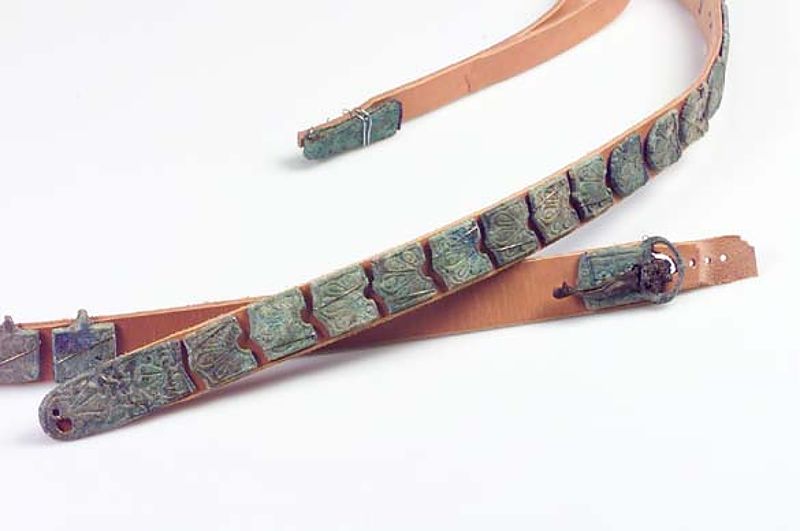
The combination of a caftan and an oriental belt, sometimes with a belt pouch with mounts of a similar type, has its origins in the Byzantine uniform code 7 . The rank and status portrayed is emphasized by the number of mounts on the belt. The original meaning of this specific dress combination might have already been lost when it reached Scandinavia, but the connection to the elite was still present.
Cloak, ringed pins and ring brooches
Another common dress element which appears in the graves with tunic remains is the cloak, which was held together using a ring brooch or ringed pin10 . Only one of the graves yielded fabric remains of the cloak: Bj 716, with a piece of woolen fabric W 6 - a twill with 10 z-spun threads per cm in the warp and 4-5 threads per cm of unknown spinning direction in the weft1 2 . Two of the graves included a ringed pin, eight a ring brooch.
The ringed pin from Bj 1076 has been re-worked into a clasp; it is of a type of seemingly Scandinavian origin. From Bj 977 comes a ringed pin with parallels in Gotlandic hoard finds from the 10th century11 .
The eight ring brooches belong to six different types12 , of which three show strong Eastern13 and one more West European influences 14 . The "Eastern" brooches were found in Bj 716, 855 and 957 (type II-1; ring brooches of bronze with polygonal end knobs), Bj 1074 (type II-4; ring brooch of bronze with end knobs decorated with small cones) as well as Bj 904 (type I-1; ring brooch of iron with rolled-up ends). The "West European" ring brooch from Bj 944 is made of iron and has the ends cut. From Bj 735 comes a brooch of type VI: ring brooch with face masks. Only a few similar finds come from Scandinavia. It was made of gilt bronze. The last of the ring brooch finds from the tunic graves is from Bj 958 and does not have any parallels anywhere. It is made of bronze and iron and shows evidence of white metal as well as some decorative stamps.
Head dresses
In three of the tunic graves, head dresses (or what is left of them) have been found1 : Bj 716 contained a tablet woven band with gold thread which would have been worn like a diadem. In Bj 944, a silver posament (P 11) was found in combination with gilt Chinese silk (S 3) and a piece of another kind of silk (S 5). The type of posament that belonged to the head dress has also been found on the caftan from the same grave. In Bj 957, a long silver posament (P 10) has been found where the head would have been.
References:
- Hägg, Inga, "Die Tracht." Birka II 2: 51-72,
- Geijer, Agnes, Birka III: die Textilfunde aus den Gräbern. Almqvist & Wiksell, 1938.
- Arbman, Holger. Birka: Untersuchungen und Studien. 1, Die Gräber: Text. Vitterhets-, historie-och antikvitetsakad, 1940.
- Hägg, Inga, and Jansson, Ingmar. Kvinnodräkten i Birka: livplaggens rekonstruktion pa grundval av det arkeologiska materialet. Institutionen för arkeologi Gustavianum, 1974.
- Hägg, Inga Birkas orientaliska praktplagg. Fornvännen 78, 204-223, 1983.
- Avdusin, Daniil Antonovic Three chamber graves at Gniozdov. Fornvännen 83, 20-33, 1988.
- Krag, Anne Hedeager Oriental Influences in the Danish Viking Age: Kaftan and Belt with Pouch. North European Symposium for Archaeological Textiles X, edited by Eva Andersson Strand et al., vol. 5, Oxbow Books, Oxford; Oakville, pp. 113–116, 2010.
- Jansson, Ingmar Gürtel und Gürtelzubehör vom orientalischen Typ. Birka II 2: 77-108, 1986
- Gräslund, Anne-Sofie Beutel und Taschen. Birka II 1: 141-154, 1984
- Ģinters, Valdemār Tracht und Schmuck in Birka und im ostbaltischen Raum: eine vergleichende Studie. Almqvist & Wiksell, 1981.
- Thunmark-Nylén, Lena Ringnadeln. Birka II 1: 5-14, 1984
- Thålin, Harry Ringspangen. Birka II 1: 15-22, 1984
- Ģinters, Valdemār Der Ursprung der Ringspangen vom östlichen Typ. Birka II 1: 23-30, 1984
- Graham-Campbell, James Western influences on penannular brooches and ringed pins. Birka II 1: 31-38, 1984